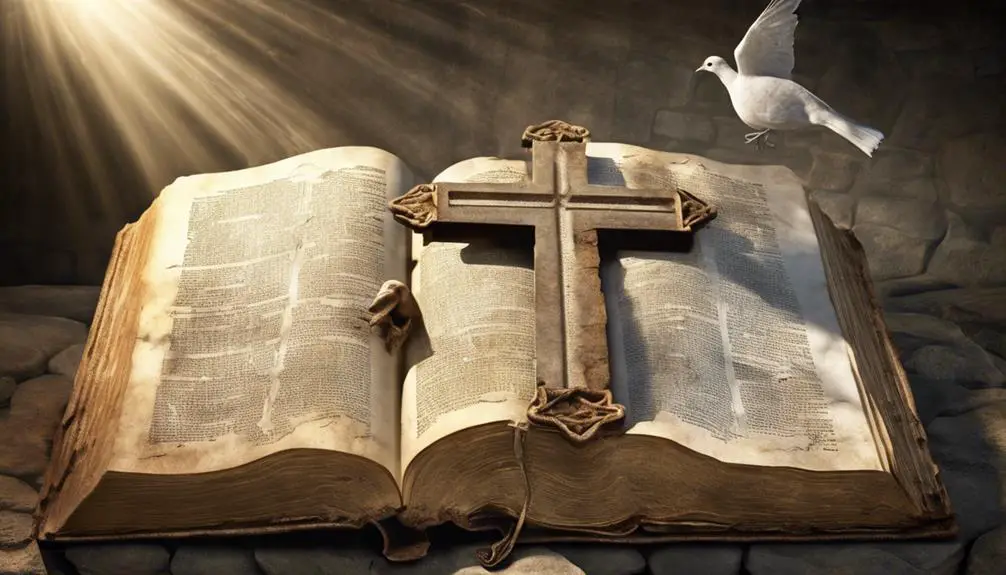An exploration of biblical patterns unveils a complex tapestry of themes, inviting readers on a journey of discovery and deeper understanding.

Patterns in the Bible
You might think the Bible is too complex or dull to offer any discernible patterns, but you'd be surprised at the richness and depth awaiting your exploration. From the symbolic use of numbers that weave through the text to the repeating motif of exodus that signifies liberation and divine guidance, the scripture unfolds in patterns that both inspire and challenge.
By examining these patterns, such as the creation narrative's cosmic order, Jesus' parables, and the vivid apocalyptic visions, you'll uncover a tapestry of themes that resonate with human experience across ages. This journey promises to reveal insights that not only deepen your understanding but spark a new appreciation for the biblical narrative.
Key Takeaways
- Numerical symbolism in scripture reveals deeper meanings and divine blueprints.
- Creation narratives underscore the importance of order and harmony in the universe.
- The Exodus story highlights themes of liberation and divine guidance through trials.
- Parables and apocalyptic visions challenge and encourage reflection on spiritual truths.
Numerical Symbolism in Scripture

Numerical symbolism in Scripture profoundly influences how you understand biblical narratives, with numbers often carrying deeper meanings beyond their face value. When you delve into the details, you'll find that temple measurements and genealogical ages aren't just arbitrary numbers; they're imbued with symbolic significance that echoes throughout the text, offering insights into the divine blueprint of creation and the spiritual lessons intended for the reader.
For instance, the meticulous dimensions of the temple, as described in Kings and Chronicles, aren't merely architectural details. They symbolize perfection, order, and the divine presence among the people. These measurements invite you to ponder the structured nature of the divine-human relationship, reflecting a cosmos harmonized by God's decree.
Similarly, the genealogical ages recorded in Genesis serve more than a historical account. They're laden with symbolic value, representing the flow of divine blessing through generations, the longevity of righteousness, and the impact of sin on human mortality. By analyzing these ages, you're not just tracing lineage; you're exploring the depth of God's interactions with humanity over time.
Understanding these numerical symbols enriches your comprehension of the Bible's narratives, unveiling layers of meaning that might otherwise go unnoticed.
Creation and Cosmic Order
How does the biblical narrative weave the concept of creation and cosmic order into its fabric, showcasing a universe meticulously designed and governed by divine laws? The Bible presents the cosmos as a masterpiece of divine architecture, a testament to the Creator's power and wisdom. This narrative isn't just about the origins of the earth and humanity; it's a profound statement on the nature of reality itself, structured around sacred time and cosmic order.
- Divine Architecture: The creation story is structured to highlight the careful planning and execution of the universe. Every element, from the stars in the sky to the creatures of the sea, fits into a harmonious design, reflecting the Creator's meticulous attention to detail.
- Sacred Time: The concept of the Sabbath introduces a rhythm into the cosmic order, marking a sacred time that underscores the importance of rest and reflection in the divine scheme.
- Order from Chaos: The narrative describes the world's transformation from a formless void into a well-ordered cosmos, illustrating the divine power to bring order from chaos.
- Human Role: Humanity is cast as stewards of this creation, tasked with maintaining its order and harmony, highlighting our integral role within the divine plan.
This detailed design invites you to contemplate the profound interconnectedness of all things under the governance of divine laws.
The Exodus Pattern

Within the tapestry of the biblical narrative, the Exodus pattern emerges as a pivotal demonstration of liberation and divine intervention, intricately connecting human history with God's redemptive plan. At the heart of this narrative is Moses' leadership, a key element that guides the Israelites out of bondage. Opposing him is Pharaoh's defiance, an embodiment of the oppressive forces that stand against God's will.
Element |
Significance |
|---|---|
Moses' Leadership |
Embodies divine guidance and perseverance, leading to the liberation of the Israelites. |
Pharaoh's Defiance |
Represents the resistance to divine will, highlighting the struggle between freedom and oppression. |
Moses' confrontations with Pharaoh aren't just historical accounts; they symbolize the enduring battle between tyranny and deliverance. Through Moses, you see the importance of steadfast faith and leadership under divine guidance. Pharaoh's stubborn resistance underscores the destructive nature of defiance against what is just and ordained by a higher power.
This pattern isn't just a narrative; it's a profound lesson in faith, leadership, and the power of divine intervention. It serves as a reminder that liberation often comes through trials, guided by a steadfast commitment to a higher calling.
Parables and Teachings of Jesus
Often, Jesus employed parables and teachings to convey complex spiritual truths in a relatable and profound manner. By using everyday scenarios, He imparted wisdom that has resonated through the ages. Consider the parables of the lost sheep and the forgiving father, both of which encapsulate the core of His message—forgiveness, redemption, and the boundless love of God. Here's a deeper look at their significance:
- Lost Sheep: This parable illustrates God's relentless pursuit of those who've strayed. You're reminded that no one is too far gone to be saved or unworthy of God's grace.
- Forgiving Father: Also known as the Prodigal Son, this story highlights the nature of repentance and the joy of reconciliation. It teaches you about the unconditional love of God and His readiness to welcome back the repentant heart.
These narratives serve multiple functions:
- They demystify divine principles, making them accessible and applicable to daily life.
- They encourage introspection and self-assessment in your spiritual journey.
- They reinforce the idea of a compassionate, forgiving God, challenging you to extend the same grace to others.
- They offer hope and redemption, assuring you that transformation is always possible, regardless of past mistakes.
Apocalyptic Visions and Prophecies

In exploring biblical apocalyptic visions and prophecies, you'll uncover revelations that have intrigued scholars and believers alike for centuries. These texts, dense with symbolism and forewarning, offer a glimpse into the end times, as perceived by ancient prophets. Central to these visions is the complex beast symbolism, representing various forms of earthly and spiritual corruption. You'll find that these beasts aren't merely creatures of fantasy but are imbued with meanings, each one a metaphor for the pervasive evils that prophets warned would lead to humanity's downfall.
Moreover, angelic interventions play a crucial role in these apocalyptic scenarios. Angels are depicted not only as messengers but also as agents of divine action, executing judgments and offering protection to the faithful. This interaction between the divine and the earthly highlights a key theme in apocalyptic literature: the ongoing battle between good and evil, with the divine realm actively participating in the affairs of humanity.
As you delve deeper, you'll appreciate the richness and complexity of these apocalyptic visions and prophecies. Their detailed narratives and symbolic language invite a deeper reflection on the moral and spiritual challenges facing humanity, both in the past and in the present day.
Frequently Asked Questions
How Do the Cultural and Historical Contexts of the Time Influence the Interpretation of Patterns in the Bible?
The cultural and historical contexts greatly influence how you interpret patterns. Archaeological findings and scriptural translations provide insights into the era's beliefs and practices, affecting your understanding.
Without considering these aspects, you might miss the significance of certain patterns. Therefore, it's crucial to delve into these contexts to grasp the full meaning.
This approach ensures that interpretations aren't only accurate but also reflect the intended message of the time.
In What Ways Do Patterns in the Bible Contribute to the Development of Character and Narrative Arcs?
Patterns play a pivotal role in shaping narratives and characters. Through symbolic repetition, you'll find characters evolving, reflecting moral parallels that guide their journeys.
These patterns aren't just fillers; they're the backbone, providing depth and complexity. They help you understand a character's motivations and transformations, making the story richer and more engaging.
Essentially, they're the threads that weave the tapestry of the narrative, offering insights and enhancing the storytelling experience.
How Do Different Denominations and Faith Traditions Interpret the Significance of These Patterns Differently?
You'll find that denominations and faith traditions have varied takes on symbolic numerology and eschatological themes. Some see numbers as deeply symbolic, influencing their interpretation of texts. Others prioritize eschatological themes, viewing patterns as clues to understanding end times. This divergence shapes their doctrinal teachings and beliefs.
It's crucial to grasp these differences to fully appreciate how each tradition views scripture, ultimately affecting their theological outlook and practices.
What Role Do Linguistic Patterns and Wordplay in the Original Languages of the Bible Play in Its Interpretation?
You're diving into how the subtle play of words and numbers shapes your understanding of texts. Consider this: over 70% of ancient scripts use numerical symbolism to convey deeper meanings.
In the Bible, linguistic patterns and wordplay, like phonetic echoes, aren't just stylistic; they're interpretive keys. They reveal layers of meaning, reflecting the text's divine craftsmanship. Analyzing these patterns offers a richer insight, highlighting the intricate relationship between language and message.
How Have Modern Scholars and Theologians Challenged or Expanded Upon Traditional Understandings of Patterns in the Bible?
You've seen modern scholars and theologians push beyond traditional views by digging into numerical symbolism and prophetic imagery. They've used these elements to reveal deeper meanings and connections that were previously overlooked.
Conclusion
In light of the intricate patterns woven throughout the Bible, from numerical symbolism to cosmic order, one can't help but marvel at its complexity. How can we ignore the profound connections between creation, exodus, parables, and apocalyptic visions? These patterns aren't mere coincidences; they're a testament to a deeper, divine structure guiding the scripture.
As we delve into these narratives, we uncover layers of meaning that challenge and enrich our understanding, compelling us to look beyond the surface.



Sign up